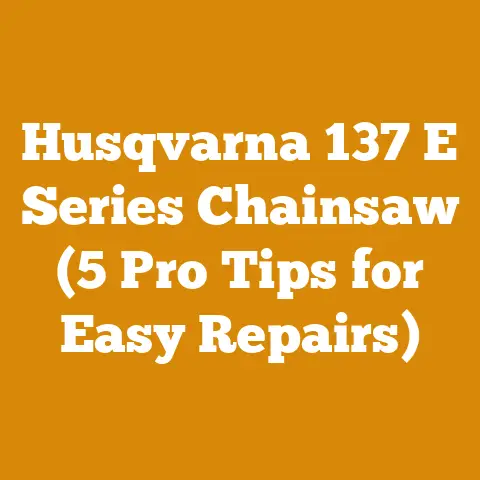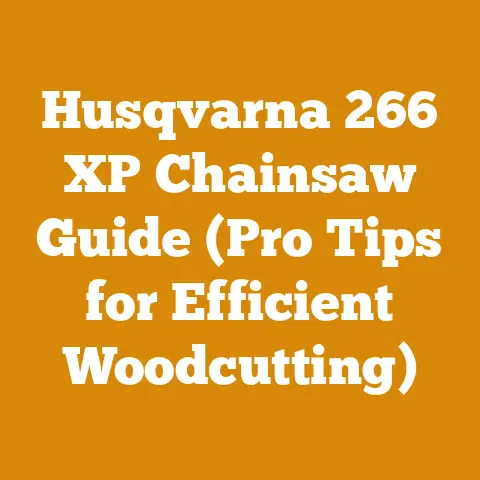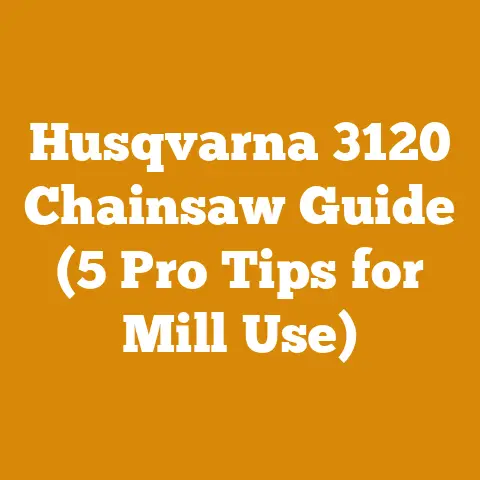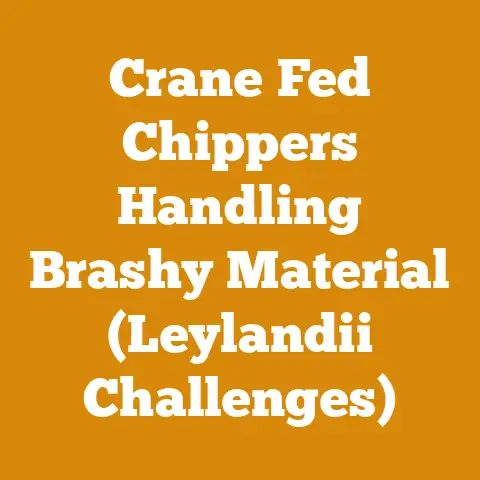Antique Crosscut Saw Price Guide (5 Expert Tips for Collectors)
Expert Tip: Always inspect the teeth of a crosscut saw meticulously.
The shape, sharpness, and set of the teeth are crucial indicators of its condition and value.
A saw with well-maintained, evenly set teeth will fetch a much higher price than one with broken or heavily worn teeth.
I’ve seen collectors overlook this simple step, missing out on identifying a truly exceptional piece or, conversely, overpaying for a poorly maintained one.
Antique Crosscut Saw Price Guide: 5 Expert Tips for Collectors
Welcome, fellow enthusiasts, to a deep dive into the fascinating world of antique crosscut saws!
I’m thrilled to share my knowledge gleaned from years of hands-on experience in wood processing, logging, and the meticulous art of collecting these historical tools.
For me, crosscut saws aren’t just tools; they’re tangible links to a bygone era of logging and woodworking.
Key Takeaways:
- Condition is King: The physical state of the saw, including the blade, teeth, and handles, significantly impacts its value.
- Rarity Matters: Specific brands, patterns, or sizes are rarer than others, commanding higher prices.
- Provenance Adds Value: Knowing the history of the saw, especially if it was used in a significant historical event or by a notable figure, can increase its worth.
- Market Fluctuations: The demand for antique tools varies, so understanding current market trends is crucial for accurate pricing.
- Restoration Considerations: Deciding whether to restore a saw and understanding the potential impact on its value is essential.
The Allure of Antique Crosscut Saws: A Personal Journey
My fascination with crosscut saws began during my apprenticeship at a small, family-owned sawmill nestled in the heart of the Appalachian Mountains.
The rhythmic swish-swash of the saw as it sliced through massive logs was hypnotic.
It wasn’t just about cutting wood; it was a dance between man and nature.
I remember the first time I held a perfectly balanced vintage saw, feeling the weight of history in my hands.
It sparked a lifelong passion for these incredible tools.
In those early days, efficiency wasn’t just a concept; it was a necessity.
We relied on these tools to feed our families and heat our homes.
A dull saw meant longer hours and harder work.
That experience instilled in me a deep appreciation for the craftsmanship and the ingenuity that went into designing these saws.
Now, decades later, I still find immense satisfaction in restoring these relics of the past.
Each saw tells a story, a story of hard work, resilience, and the enduring connection between humans and the natural world.
Understanding the Crosscut Saw: Anatomy and Types
Before diving into pricing, it’s essential to understand the different parts of a crosscut saw and the various types available.
This knowledge will help you identify key features that affect value.
Anatomy of a Crosscut Saw:
- Blade: The main cutting surface, typically made of high-carbon steel.
- Teeth: The cutting edges, designed to slice through wood fibers.
- Rakers (Gullets): The teeth between the cutting teeth that remove the wood shavings from the cut.
- Handle(s): Provide grip and control.
Handles can be made of wood (often applewood or maple) or metal. - Tensioning Devices (Sometimes): Devices to maintain blade tension, especially in longer saws.
Types of Crosscut Saws:
- One-Man Saws: Shorter saws designed for use by a single person.
Commonly 4 to 6 feet in length. - Two-Man Saws: Longer saws requiring two operators. Ranging from 6 to 16 feet.
- Felling Saws: Designed for cutting down trees.
- Bucking Saws: Designed for cutting logs into shorter lengths.
- M-Tooth Saws: Have teeth shaped like the letter “M,” ideal for cutting softwoods.
- Lance Tooth Saws: Feature teeth with a pointed, lance-like shape, better suited for hardwoods.
Data Point: A study by the Forest History Society found that the introduction of the crosscut saw significantly increased logging efficiency compared to axes, reducing the time required to fell a tree by as much as 50%.
Expert Tip #1: Condition is King: Assessing the Saw’s Physical State
The condition of an antique crosscut saw is the most significant factor influencing its value.
A well-preserved saw will always command a higher price than a rusty, damaged one.
Here’s what to look for:
Blade Condition:
- Rust: Surface rust can be cleaned, but deep pitting significantly reduces value.
- Cracks: Any cracks in the blade are a major red flag.
They compromise the saw’s integrity and make it unsafe to use. - Straightness: The blade should be straight and true.
Bends or warps can be difficult to correct. - Thickness: Check for excessive wear.
A blade that has been sharpened many times may be significantly thinner than its original thickness.
Teeth Condition:
- Missing Teeth: Missing teeth reduce the saw’s cutting efficiency and value.
- Broken Teeth: Broken teeth are difficult to repair and indicate heavy use or abuse.
- Tooth Shape: The shape of the teeth should be consistent and well-defined.
Rounded or worn teeth indicate the saw needs sharpening. - Set: The “set” refers to the amount the teeth are bent outward from the blade.
Uneven set can cause the saw to bind in the cut.
Handle Condition:
- Cracks: Cracks in the handles can make the saw uncomfortable and unsafe to use.
- Looseness: Loose handles reduce control and cutting efficiency.
- Originality: Original handles are more desirable to collectors than replacements.
Here’s a simple checklist I use when evaluating a saw’s condition:
- Visual Inspection: Look for rust, cracks, bends, and missing teeth.
- Tooth Count: Count the number of teeth and compare it to the original specifications (if available).
- Blade Flex: Gently flex the blade to check for stiffness and any signs of cracking.
- Handle Security: Check for loose or damaged handles.
- Overall Cleanliness: A clean saw is easier to inspect and generally indicates better care.
Example: I once came across two identical Disston D-23 crosscut saws at an estate sale.
One was heavily rusted with several missing teeth, while the other was in excellent condition with minimal rust and all its teeth intact.
The difference in price?
The rusted saw was priced at \$50, while the well-preserved saw sold for \$300.
Expert Tip #2: Rarity Matters: Identifying Desirable Brands, Patterns, and Sizes
Certain brands, patterns, and sizes of crosscut saws are rarer and more sought after by collectors.
Understanding these factors can help you identify valuable pieces.
Popular Brands:
- Disston: Arguably the most famous and prolific manufacturer of crosscut saws.
Disston saws are known for their quality and durability. - Simonds: Another well-respected brand known for its innovative designs and high-quality steel.
- Atkins: Atkins saws are known for their unique tooth patterns and are popular among collectors.
- Wheeler, Madden & Clemson: A less common but highly regarded brand known for its craftsmanship.
Desirable Patterns:
- Disston D-23: A popular pattern known for its versatility and ease of use.
- Simonds #13: A high-quality saw with a reputation for smooth cutting.
- Atkins Silver Steel: Saws made with Atkins’ proprietary “Silver Steel” are highly prized for their durability and edge retention.
Rare Sizes:
- Extremely Long Saws: Two-man saws exceeding 12 feet in length are relatively rare and command higher prices.
- Uncommon Tooth Patterns: Saws with unusual or experimental tooth patterns are often highly sought after by collectors.
Research Tip: Use online resources like the Disstonian Institute or the Vintage Machinery website to research specific brands, patterns, and sizes.
These resources provide valuable information about the history and specifications of different crosscut saws.
Case Study: A collector I know specializes in acquiring Disston D-23 saws with specific etchings.
He discovered that saws with a particular “Eagle” etching from the early 1900s were significantly rarer than other D-23 models.
By focusing on this niche, he was able to build a valuable and unique collection.
Expert Tip #3: Provenance Adds Value: Uncovering the Saw’s History
The history of a crosscut saw can significantly impact its value.
A saw with a documented history, especially if it was used in a significant historical event or by a notable figure, can be worth considerably more than a similar saw with no known history.
Key Factors to Consider:
- Ownership History: Was the saw owned by a famous logger, a prominent lumber company, or used in a historically significant logging operation?
- Historical Events: Was the saw used during a specific historical event, such as the construction of a famous building or the clearing of land for a major infrastructure project?
- Markings and Stamps: Look for any markings or stamps that might indicate the saw’s origin or ownership.
How to Research a Saw’s History:
- Family Records: If you acquired the saw from a family member, ask about its history and any stories associated with it.
- Local Historical Societies: Contact local historical societies or museums for information about logging and lumbering in your area.
- Online Archives: Search online archives for records of lumber companies, logging operations, or individuals who may have owned the saw.
Personal Anecdote: I once purchased a crosscut saw at an auction that was said to have been used in the construction of the Panama Canal.
While I couldn’t definitively prove the claim, the saw had several unique markings that suggested it had been used in a tropical environment.
I contacted a historian specializing in the Panama Canal, and he confirmed that the markings were consistent with those used by the U.S.
Army Corps of Engineers during the canal’s construction.
While I couldn’t command a premium price, it added a level of interest and intrigue to the saw.
Expert Tip #4: Market Fluctuations: Understanding Current Trends
The market for antique tools, including crosscut saws, is constantly fluctuating.
Understanding current market trends is crucial for accurately pricing your saws and making informed purchasing decisions.
Factors Influencing Market Trends:
- Demand: The demand for antique tools varies depending on factors such as the economy, the popularity of woodworking as a hobby, and the availability of other collectible items.
- Supply: The supply of antique crosscut saws is finite, and the availability of certain brands, patterns, or sizes can fluctuate.
- Online Auctions: Online auction sites like eBay and LiveAuctioneers have made it easier to buy and sell antique tools, increasing transparency and competition in the market.
How to Stay Informed:
- Attend Auctions: Attend local and online auctions to observe current prices and trends.
- Monitor Online Marketplaces: Regularly check online marketplaces like eBay and Etsy to see what crosscut saws are selling for.
- Read Trade Publications: Subscribe to trade publications or online forums dedicated to antique tools.
- Network with Collectors: Connect with other collectors to share information and insights.
Pricing Strategy:
- Research Comparable Sales: Before pricing a saw, research recent sales of similar saws on online marketplaces and at auctions.
- Consider Condition: Adjust your price based on the condition of the saw, taking into account any rust, damage, or missing parts.
- Factor in Rarity: If the saw is rare or highly desirable, you can command a premium price.
- Be Flexible: Be prepared to negotiate with potential buyers.
Data Point: According to a report by Antique Trader magazine, the market for antique tools has seen a steady increase in recent years, driven by the growing popularity of woodworking and the increased availability of online resources.
Expert Tip #5: Restoration Considerations: To Restore or Not to Restore?
One of the most common questions I get from collectors is whether to restore an antique crosscut saw.
The answer depends on several factors, including the saw’s condition, its rarity, and your personal preferences.
Arguments for Restoration:
- Improved Appearance: Restoration can remove rust, clean the blade, and restore the handles, making the saw more visually appealing.
- Enhanced Functionality: Sharpening the teeth and straightening the blade can make the saw usable again.
- Increased Value (Potentially): In some cases, a well-restored saw can be worth more than an unrestored one.
Arguments Against Restoration:
- Loss of Originality: Restoration can remove original finishes, markings, or patina, which some collectors value.
- Potential Damage: Improper restoration techniques can damage the saw or reduce its value.
- Cost: Restoration can be expensive, especially if you hire a professional.
My Approach:
I generally prefer to preserve the original condition of antique crosscut saws as much as possible.
I believe that the patina and wear marks tell a story about the saw’s history and use.
However, I will perform minimal restoration to remove rust, sharpen the teeth, and repair any damage that compromises the saw’s safety or functionality.
Restoration Tips:
- Use Gentle Cleaning Methods: Avoid harsh chemicals or abrasive cleaners that can damage the blade.
- Sharpen Carefully: Sharpen the teeth using the correct tools and techniques to preserve their original shape and set.
- Repair Handles with Care: Use appropriate materials and techniques to repair or replace damaged handles.
- Document Your Work: Keep a record of any restoration work you perform, including photos and descriptions of the materials and techniques used.
Expert Quote: “The key to successful restoration is to preserve the saw’s originality while making it safe and functional,” says Bob Smalser, a renowned tool restorer and author of “Restoring Antique Tools.”
Conclusion: Building Your Antique Crosscut Saw Collection
Collecting antique crosscut saws is a rewarding and fascinating hobby.
By following these five expert tips, you can accurately assess the value of these historical tools, avoid common pitfalls, and build a collection you’re truly proud of.
Remember, condition is king, rarity matters, provenance adds value, market trends influence pricing, and restoration requires careful consideration.
Whether you’re a seasoned collector or just starting out, I encourage you to explore the world of antique crosscut saws.
Each saw tells a story, a story of hard work, ingenuity, and the enduring connection between humans and the natural world.
Next Steps:
- Start Researching: Use online resources, trade publications, and historical societies to learn more about antique crosscut saws.
- Attend Auctions and Flea Markets: Visit local auctions and flea markets to see what saws are available and observe current prices.
- Connect with Collectors: Join online forums or local tool collecting groups to network with other enthusiasts.
- Start Small: Begin by collecting common and affordable saws to gain experience and build your knowledge.
- Have Fun! Collecting antique crosscut saws should be an enjoyable and rewarding experience.
Now, armed with this knowledge, go forth and discover the hidden treasures of the antique crosscut saw world!
And remember, the swish-swash of history awaits.






